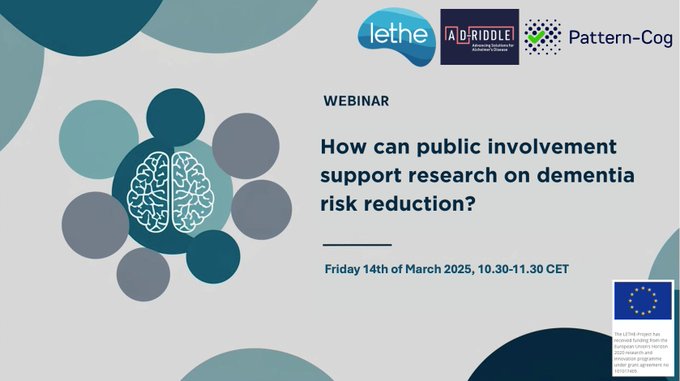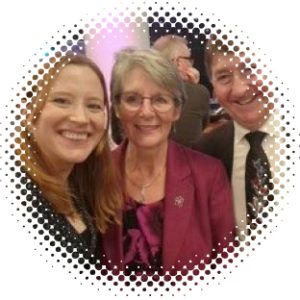The first year of the Pattern-Cog project has just concluded. In this short piece, we wanted to reflect back on some of the important advances and major achievements made by each Work Package (WP). We would like to thank all partners for their impressive work and we look forward to the busy months ahead!
WP1: Extension of BrainAGE framework and development of MRI-derived local confidence maps
- Building normative database of healthy controls (downloaded > 10.000 datasets)
- Data from 6 samples are fully pre-processed and quality-checked and the resulting segmentations are ready to be used as the first normative database.
- Completed the implementation of the Gaussian Process Regression as a new framework for our BrainAGE estimation. This new framework provides ensemble learning, repeated k-fold, trend-correction and Monte Carlo Dropout.
WP2: Personalised ageing pattern framework based on multi-view learning
- Study prediction of future amyloid burden/positivity using ADNI data
- Developing Machine Learning (ML) approaches for relevant prediction tasks in very early signs of dementia and intervention
- Looking at how to use longitudinal (imaging, cognitive) data for different prediction tasks.
WP3: High-performance algorithm for screening healthy individuals for risk of impending MCI and subsequent AD
- Looking at polygenic risk scores (PRS) in predicting conversion to Mild Cognitive Impairment in a short and longer term
- Polygenic risks scores to quantify Alzheimer’s disease genetic risks, developed by the Bellenguez and de Rojas methods have been incorporated as features for the prediction.
- Blood biomarkers (i.e. NFL, GFAP, P-tau181, Ab40, Ab42) have been added to the prediction models.
WP4: Personalised ageing pattern framework in cognitive decline/dementia prevention RCTs
- Recruitment for the MET-FINGER randomized clinical trial (RCT) has started in one of the 3 sites. The RCT will recruit a total of 600 participants from Finland, Sweden, and United Kingdom.
- Preparatory work for neuroimaging data collection and processing in RCTs is being done.
- One article has been published (Rydstrom et al., Gerontology, DOI: 10.1159/000530688), with work reflecting the role of brain integrity (multiple indicators used) in the association between mentally stimulating activities (occupational complexity) and cognition in older adults at risk of dementia (FINGER neuroimaging cohort).
WP5: Ethical, legal and social aspects of personalised medicine in dementia prediction/prevention
Data aspects:
- First data set stored in the GDPR compliant Virtual Research Environment (VRE, vre.charite.de) – a node of the health data cloud (HDC, healthdatacloud.eu) operated by Charité made discoverable via EBRAINS Knowledge Graph
- Access is in compliance with EU law and requires conclusion of Standard Contractual Clauses (SCC) as described in the data sharing conditions
- First digital human twin use case served in the HDC was published in nature Communications. 650 virtual human brain twins have been simulated and generated new insights on principles of human cognition.
Patient and Public Involvement (PPI):
- Development of the relevant documents to contact potential people interested in joining the Pattern-Cog advisory board.
- The Pattern-Cog advisory board was set up by Alzheimer Europe in early March 2023, and it is composed of members of the European Dementia Carers Working Group (EDCWG). This group is currently composed of 14 members, who are carers, relatives and supporters of people with dementia or carers with prior experience of caring.
- Fist consultation held in Brussels on 22 March 2023 with the members of the Pattern-Cog Advisory Board around the topic of risk prediction and disclosure of the risk of cognitive impairment in cognitively healthy people.
- Working on the recommendations on language and frame relating to the disclosure of machine learning-based risk predictions, based on the feedback received from the above consultation.
WP6: Communication and dissemination
- Development of a corporate identity (i.e. logo and its guidelines, templates such as slides, letter, poster) to be used in all communication materials related to the project
- Setting up a plan for external communication and dissemination activities defining the communication objectives, identifying the relevant target audiences and describing the channels and tools to be used. This communication plan resulted in the development of the Pattern-Cog Communication strategy, as part of deliverable D6.2
- Creation of social media accounts to communicate all relevant information about the project (i.e. Twitter, LinkedIn) and launch of the project’s website. Both activities are reported in the deliverable D6.3 Pattern-Cog website & social media channels
- Communication to the wider dementia community with publication of Pattern-Cog news items on the Alzheimer Europe website and its monthly e-newsletter.
WP7: Management
- Finalisation of the Consortium agreement
- Establishment of an internal repository (SharePoint)
- Development and finalisation of the data management plan
- Regular online Executive Management Board (EMB) meetings with project leaders
- Preparation of the Pattern-Cog General Assembly Meeting to be held on 19 October 2023 in Helsinki.

















